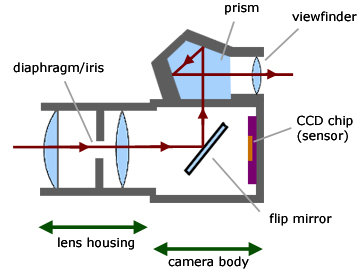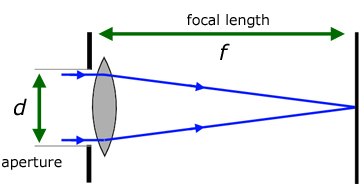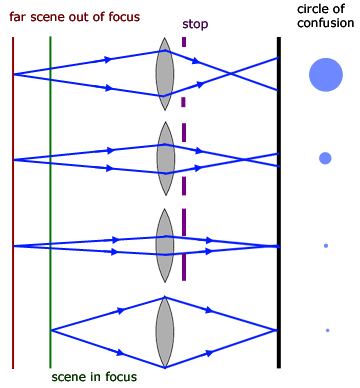Home >> Optics, the camera
intro |
Introduction - the single lens reflex camera (SLR)

lens - lenses are compound in nature and of sophisticated design, with most offering the facility to zoom in on an image.
shutter - this controls the flip mirror, which rotates about its top edge into the camera body.
viewfinder - the image can be viewed directly through the lens system via the flip mirror and the penta-prism.
diaphragm/iris - is a variable aperture. By rotation, the light entering the lens increases/decreases. Hence the f-number of the lens can be altered.
ccd (charge coupled device) - a silicon chip consisting of an array of capacitor-like elements that store charge when light falls on them. The amount of electric charge stored in each element is proportional to the light intensity at that point.
f-number

As might be expected, the total amount of light (L) falling on a sensor/film is proportional to the area of the aperture (A), which in turn is proportional to diameter squared ( d 2).
![]()
The area A of a circular aperture of radius r is given by:

hence,
![]()
It can be shown that the area of an image( Ai) is proportional to the square of the focal length (f).
![]()
The light per unit area of image is given by the the total amount of light in the image (L) divided by the area of the image ( Ai) .
Hence,

So the amount of light in the image relates to both the aperture diameter and the focal length. For a bright image the aperture must be large and the focal length small. Note the telephoto lenses used by photographers at sports events. Object lenses are wide with a short tapering barrel.
Further, it can be shown that exposure time ET is inversely proportional to the light per unit area of image( L/Ai).

hence,
![]()

The f-number (relative aperture) is defined as the lens focal length (f) divided by the aperture (d).
![]()
therefore,
![]()
f-number settings (blue) on a camera have discrete values.
![]()
The square of each number (red) in the series is approx. double that of the square of the number preceding it.
Since exposure time ( ET ) is directly proportional to the square of the f-number, by decreasing the f-number by one setting the exposure time is halved.
depth of field (DOF)
This is the distance between objects in the foreground and the background that appear in focus.
Depth of field depends on:
camera-to-subject distance : the further a subject is away, the sharper the image.
lens focal length : a short focal length lens gives a shallow DOF and vice versa.
f-number : a high f-number gives a deeper DOF.
circle of confusion CoC : a point is imaged as a spot rather than a point as a result of light being brought to focus infront and behind the prime image.

The DOF can be defined in terms of the CoC as: the region where the CoC is less than the resolution of the human eye (or the medium being used).
In the top three diagrams you can see how a region (in red), further away from from the lens, is out of focus. This is because light rays do meet at a point on the screen.
As the lens is stopped (aperture lowered), the blurred area becomes smaller and smaller. As a result of the limitations of the eye/media, a point is reached when a blurred spot is indistinguishable from a focussed point. The scene then has regions infront and behind that appear in focus. A depth of field is perceived.
[ About ] [ FAQ ] [ Links ] [ Terms & Conditions ] [ Privacy ] [ Site Map ] [ Contact ]
